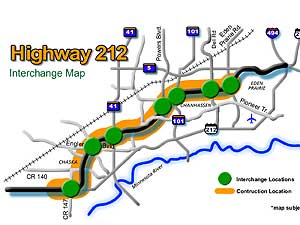June 12, 2005
 |
| Expansion plans for Highway 212 in the western Twin Cities metro area. (Image courtesy of MnDOT) |
Chaska, Minn. — The conversion of Highway 212 to a freeway-style four-lane roadway means legions of commuters will save time. Moreover, Bob Lindall says, it means drivers entering the Twin Cities from the west will now have a more direct route, rather than a hodgepodge of county roads.
"I'm sure sure it'll save a good 15 minutes, if not more, for those people from western Minnesota passing through our area," says Lindall, a member of the Chaska City Council.
Lindall has been waiting since the mid 1970s for the new Highway 212 link. Lindall is a downtown Minneapolis attorney, and the irony is he commutes to his job every day by bus.
As much as vehicle drivers, Lindall says, the new 212 link serves a batch of long distance commuters from a variety of locations. He says one of his busmates drives from Mankato, parks in Chaska and hops on the bus for the final leg to his Twin Cities job.
"This pattern of long commutes already exists, and what we're doing is trying to assist people such as that," Lindall says.
Highway 212's history is chock full of political potholes. The first plan, back in the 1950s, was for a "farm-to-market" road. The highway was to be upgraded and redirected, so trucks laden with grain from western Minnesota would have a more direct route to the mills and elevators in downtown Minneapolis.
Rep. Alice Hausman, DFL-St. Paul, a member of the Transportation Finance Committee, says times changed, and the mills and elevators moved to southern suburbs along the Minnesota River.
"The highway was actually taken off the planning sheets because it was no longer a farm-to-market road," Hausman says.
The Highway 212 project re-emerged in the l980s as people replaced farm crops. Homes began popping up in the fast-growing southwestern Twin Cities suburbs, and residents clamored for a quicker way to their jobs.
Hausman and others argued the state had higher priority transportation projects for increasingly precious road and bridge building dollars.
However during the 2003 legislative session, Highway 212 surged to the head of the line for funding.
Hausman says a key player in the resurrection was former state lawmaker and Chaska farmer Carol Molnau, now Minnesota's lieutenant governor and state transportation commissioner.
Others argue years of lobbying by developers and other business people eventually convinced lawmakers to fund the final segment.
Rep. Mary Liz Holberg, R-Lakeville, the chair of the Transportation Finance Committee, says another way of looking at 212's tumultuous history is -- the roadway was needed all along.
"Had they (highway projects) been funded on merit, they would have been funded years ago. I think it's all in your perspective," Holberg says.
Jerry Bohn's perspective is as mayor of Victoria, one of the small towns along with Young America, Norwood and Cologne which will feel the effects of the new Highway 212 segment.
Bohn says Twin Cities growth has caused Victoria's population to nearly triple the past decade, to almost 6,000 people. He predicts Victoria and other towns along and near 212 will see even faster expansion now.
"A lot of the developers are coming out there and buying up the farmland that is available, and we see a lot of new houses going up every year," Bohn says.
The pricetag for the new 11-mile segment of 212 is $238 million. The cost does not include improvements to local roads. That expense, Bohn says, will be borne in part by local property taxpayers.
"As 212 comes through, the county has a number of interchanges it has to help pay for," says Bohn. "They don't pay for the interchanges, but they pay for the upgrades to the roads that connect with the interchange."
The completion in 2008 of Highway 212 will deliver more traffic to Interstate 494, an already congested Twin Cities freeway. Advocates, however, say the third lane being added to 494 will handle the increased traffic volume.





